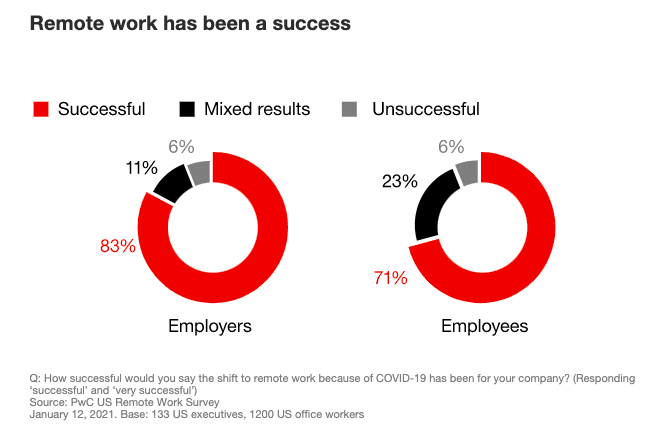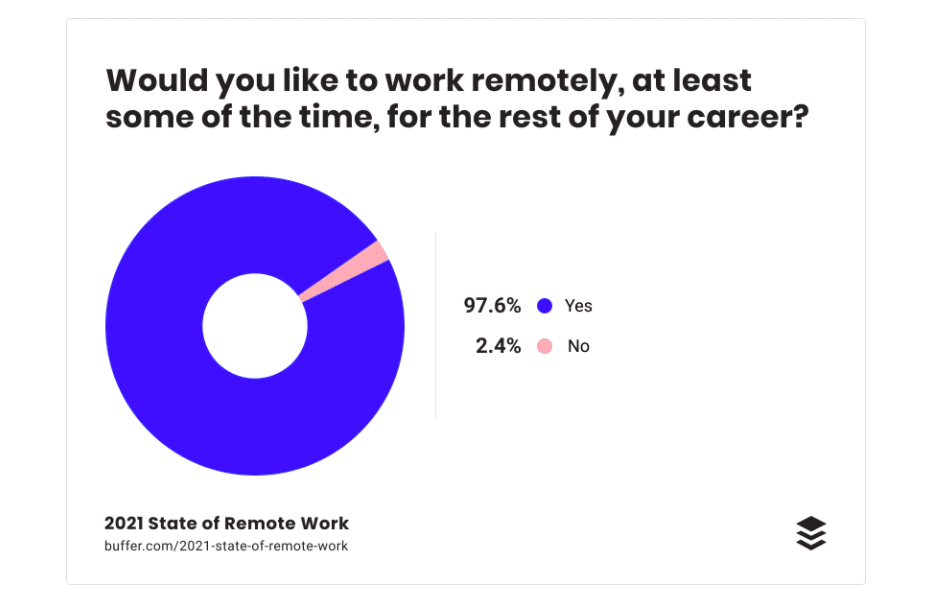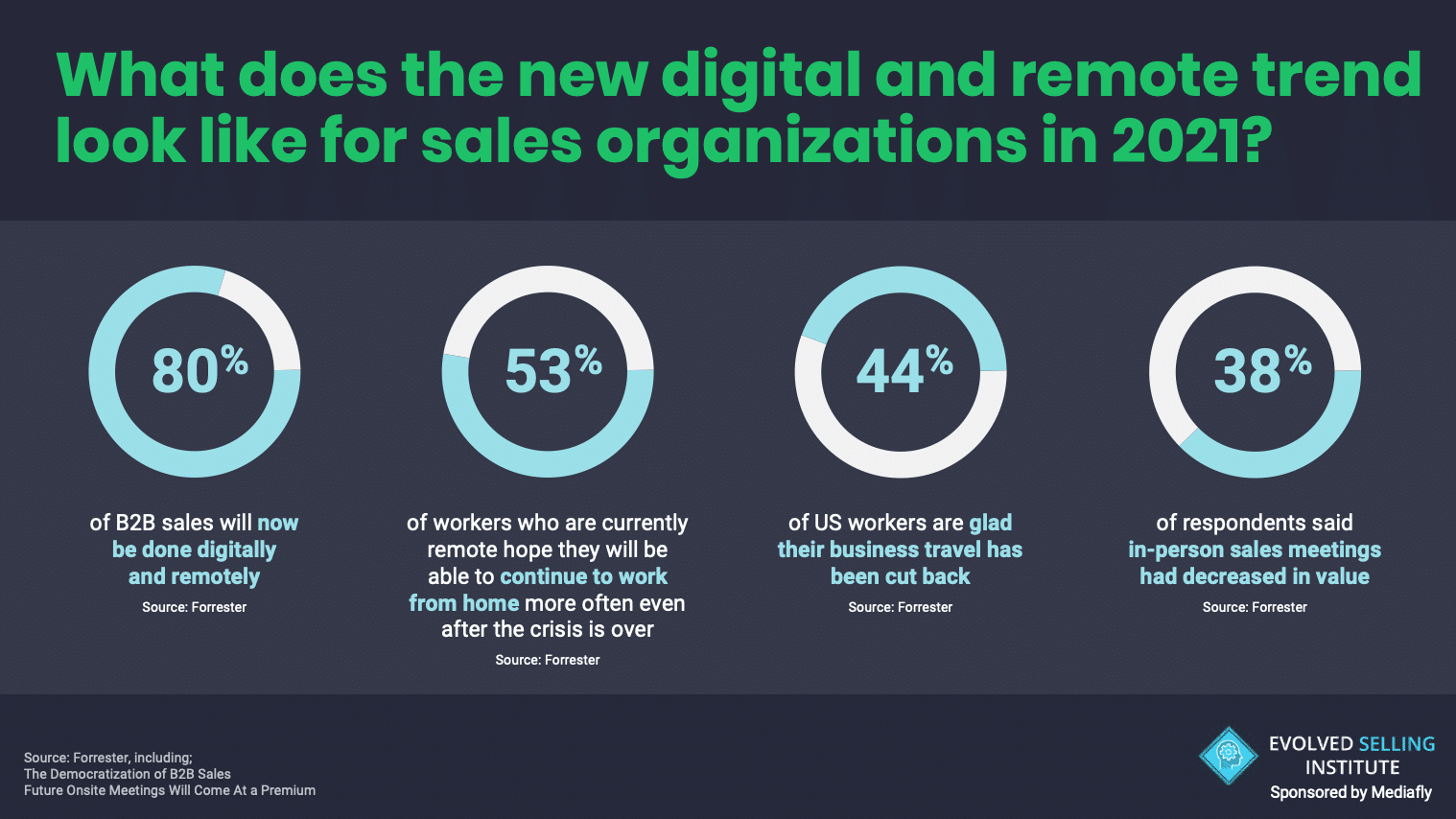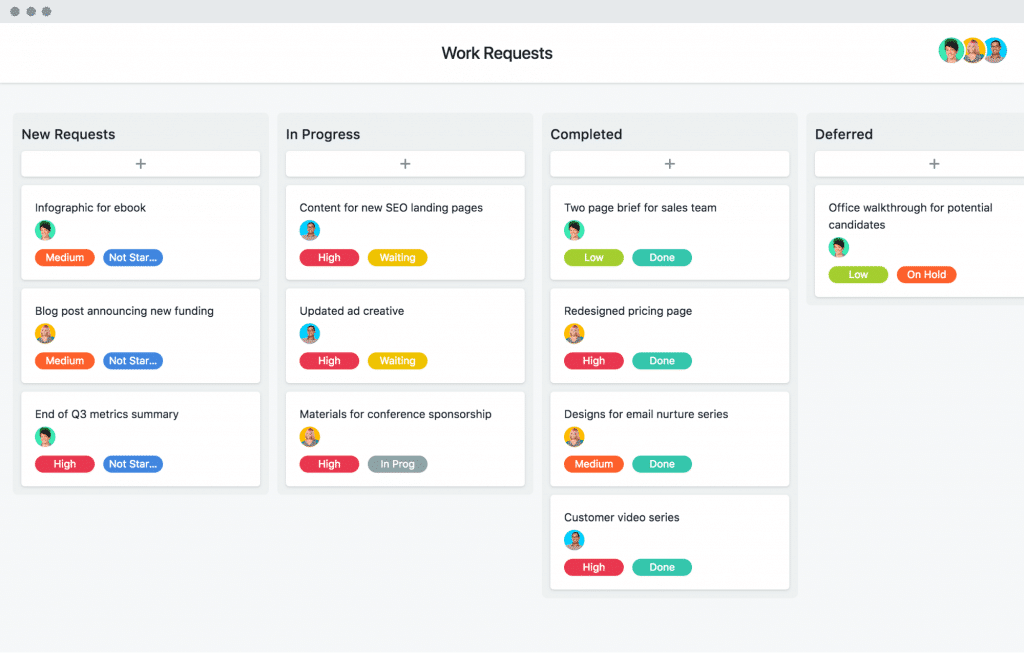As you transition your team to a remote or hybrid workplace, this article will help you:
- Determine how to best scale your temporary remote work policies and practices into a permanent remote or hybrid work model
- Uncover the tools and technologies your distributed workforce needs to continue to drive business growth
- Understand how to measure the success of your virtual work strategy and uncover opportunities for optimisation
The Future of Remote Work
It’s been more than a year since employees all over the world were forced out of their offices and into remote work settings. And while the initial expectation was that we’d all return to business as usual in a few weeks, it is now clear that remote work is here to stay.
For most, that’s a good thing. Research shows that remote work shifts caused by COVID-19 have been an “overwhelming success”. Employers report improved productivity, while the majority of employees report better work-life balance, less commute stress, and even cost savings.

Based on this data, it’s not surprising that 65% of IT executives expect at least a quarter of their organisation to work remotely after the pandemic. Similarly, 55% of surveyed employees expect to work from home more often moving forward. And, perhaps most notably, a whopping 97.6% of employees want to.

Both employees and employers are leaning into remote work, and the short-term result has been positive. But is it sustainable?
As employers map their futures in the “next” normal and contemplate new remote or hybrid work models, it’s important to understand that a permanent remote work shift will change more than just where your employees work and the schedules they run on. It will also change the tools they require to be successful. Employers who decide to embrace remote work or hybrid models moving forward will determine their fate by their ability to create a truly virtual workplace.
Are Our Current Remote Work Practices Sustainable?
When lockdowns and stay-at-home orders first became our reality, employers were quick to cobble together tools and protocol to help employees stay safe and productive at home. This included video conferencing software, business messaging applications, and project management tools such as Asana and Trello.
While these tools will certainly remain ingrained in our work day-to-day, to create an efficient and effective virtual or hybrid organisation, you must consider more than just collaboration. So how do you take the temporary fix you’ve created for remote work and scale it into a comprehensive virtual or hybrid workspace? We’ve got some ideas.
Build a Digital Ecosystem that Supports Hybrid and Remote Work Models
As we all try to do more with less, balancing competing business priorities and reduced budgets, it’s important that the tech ecosystems we create to support our hybrid or remote work environments yield the highest return on investment. As you compile your tech stack, here are some tips to set yourself up for success:
1. Stay SaaS and Secure
Remote work poses increased security risks to your organisation. To mitigate your risk, ensure you are only deploying secure and compliant technology. Address any security concerns and requirements with technology vendors in the selection phase to avoid surprises once deployed. Then, complete regular security assessments and employee security training to stay secure.
But don’t let generalised security concerns prevent you from procuring SaaS technology. The idea that SaaS applications are inherently more vulnerable than on-premises solutions is a myth. SaaS technology is better suited for companies who adopt a distributed remote work policy. They require less maintenance, reduce spend, and offer greater accessibility and flexibility.
2. Be Human
Going digital doesn’t mean you have to turn into a company of robots. With most employees and customers now working in isolation, we all crave human interaction more than ever. Video conferencing is a great first step, but what other tactics and technologies can you enlist to help foster meaningful staff and customer experiences?
Chatbots on your website? Relationship management tools for sales, marketing, and social media needs? A content hub to provide personalised content recommendations? People management tools for HR, recruiting, and payroll?
Stop thinking in terms of Business to Business (B2B) or Business to Consumer (B2C). Start thinking Human to Human (H2H).
3. Invest in Training
A recent survey revealed that while 87% of remote workers received training, 67% say they need more. Why? In a remote setting, there are no big, in-person SKO events. There is no classroom for onboarding. There is no undocumented knowledge transfer – you know, the stuff picked up from colleagues in the breakroom or shared cubicle.
Especially in today’s climate, business needs, challenges, messaging, and positioning evolve rapidly. You need to ensure your commercial teams can keep up with changes and go to market with confidence. Investing in a learning management system (LMS) such as SAP Litmos or Lessonly can help you ensure your teams have on-demand access to the information they need to be successful.

4. Enable Commercial Teams
And don’t stop at education. It’s also your responsibility to ensure your commercial teams have the resources they need to create inspiring and engaging customer experiences at every stage of the buyer journey. Selling is hard! Selling to remote buyers can feel downright impossible.
What tools do you need to create compelling content? How do you empower your sellers, marketers, and customer success reps to share that content at exactly the right time along the buyer journey?
A sales enablement platform like Mediafly can help you provide all of the revenue-generating functions of your business with always-on access to the latest and greatest content, the ability to easily pivot to address buyer challenges in real-time, and guided selling tools including ROI calculators to create better buyer experiences.
5. Improve Sales Engagement
Did you know one in three people admits to falling asleep during a PowerPoint presentation? In a remote work environment, talking at your buyers with static, linear presentations doesn’t cut it. To grab your buyers’ attention, you need to uplevel your customer interactions starting with your sales storytelling and presentation content.
Make sure your sellers are telling a story about your buyer and their challenges, not pitching your products. Use visual communication software to create engaging and interactive presentations that support these stories. People remember 20% of what they read and 10% of what they hear, but they remember 80% of what they see. To make an impact and differentiate yourself from your competitors, your sales meetings must be collaborative and compelling.

6. Reduce Siloes
Siloed technology didn’t do your business any favours before the pandemic, but now? It’s detrimental to growth.
Self-serve and remote interactions have made it easier than ever for buyers to get information. 97% of B2B buyers claim they will make a purchase in an end-to-end digital self-serve model and only 20-30% of B2B buyers want to ever interact with sales reps in-person again. This blurs the line even further between sales and marketing.
In the next normal, marketing will be increasingly responsible for revenue and should be seen as a growth partner for sales. There is no more generating leads and tossing them over the fence to sales. Today’s marketers must ensure buyers receive a standout content engagement experience across the entire buyer journey. But this isn’t possible when marketing and sales are working within their own individual tech stacks. Consolidating your sales and marketing tech stacks can help you reduce costs, improve alignment and efficiency, and drive more business.
7. Streamline Workflows
Agility and efficiency are the keys to survival in today’s business climate. Don’t stop at consolidating on one tech stack for sellers and marketers. You must also integrate the various components of your tech stack for the greatest return on your investment.

When your sales enablement platform, marketing automation software, and CRM system work together, you can maximise insight into lead generation, content and sales performance, pipeline, etc., and optimise your processes and best practices accordingly. Doing so enhances the customer experience and accelerates the buyer journey.
8. Measure What Matters
In a remote environment, we become even more reliant on data to tell us what works and what doesn’t. Make sure any technology you deploy offers analytics or dashboards that help you measure your success. What are you trying to accomplish with the software you’ve implemented?
Ensure the data you collect aligns with your specified OKRs or KPIs. For example, if your ultimate goal is revenue growth, don’t measure the effectiveness of your sales content on the number of shares or views you receive. Measure the impact of your content on revenue to determine how to best allocate your content budget moving forward.
Do one-pagers perform better than eBooks? Does one of your writers contribute more to revenue than others? Check-in often and optimise your strategy accordingly.
The Right Tech Ecosystem Will Support Remote Work and Drive Growth

A lot has changed in a very short time. And while the bandages you put on your digital strategy may have helped you get through the last year, they likely won’t empower you to take your business to the next level.
If you’re contemplating permanently taking your business fully or partially remote, you’re not alone. Now is the time to take a hard look at what’s working and what could be optimised, and determine what technology you need in your arsenal to truly digitise your remote or hybrid workplace to drive growth.
Key Takeaways
- The majority of employees have fully embraced remote work. If you want to attract top talent, you’ll want to, at minimum, offer a flexible or hybrid work set-up.
- The remote work protocol you put into place 12 months ago won’t cut it long term. If you plan to adopt a permanent remote work policy, it’s time to rethink the tools and technology your staff needs to be successful at home.
- SaaS technology is better suited for distributed workforces. It offers greater flexibility and accessibility.
- The future may be digital, but human connectivity is more important than ever.
- If you invest in the right technology and integrate it properly, you can drive increased productivity and effectiveness across your organisation.
- Consolidate your tech stacks wherever possible to improve organisational alignment and save money.
- Make sure your key performance indicators match your business goals.
Originally published Apr 20, 2021, updated Jan 16, 2023
